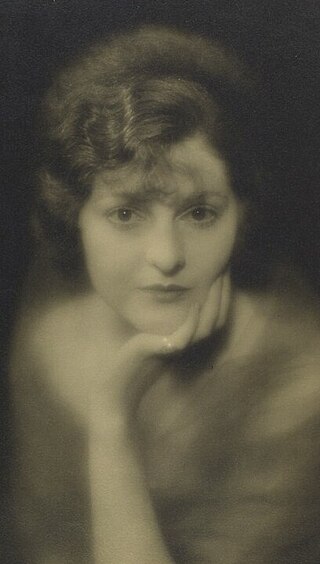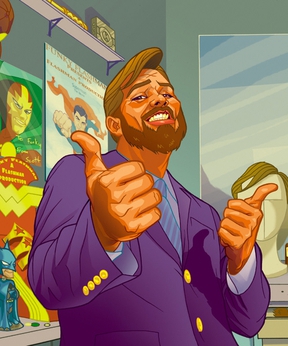
"Fourth World" was a metaseries of connected comic book titles written and drawn by Jack Kirby and published by DC Comics from 1970 to 1973. Although they were not marketed under this title until the August–September 1971 issues of New Gods and Forever People, the terms Fourth World and Jack Kirby's Fourth World have gained usage in the years since. Kirby created the Fourth World concept in the 1970s. The series is a science-fiction based mythology that revolves around ancient space deities known as the New Gods. The New Gods are similar to the gods of Earth lore.

Perfume: The Story of a Murderer is a 1985 literary historical fantasy novel by German writer Patrick Süskind. The novel explores the sense of smell and its relationship with the emotional meanings that scents may have.

Giuseppe Tartini was an Italian composer and violinist of the Baroque era born in Pirano in the Republic of Venice. Tartini was a prolific composer, composing over a hundred pieces for the violin, the majority of them violin concertos. He is best remembered for his Violin Sonata in G Minor.

Mister Miracle is the name of three fictional superheroes appearing in American comic books published by DC Comics.

Forever People are a group of extraterrestrial superheroes appearing in American comic books published by DC Comics. They first appeared in Forever People #1, and were created by Jack Kirby as part of his "Fourth World" epic.

Easter Parade is a 1948 American Technicolor musical film directed by Charles Walters, written by Sidney Sheldon, Frances Goodrich, and Albert Hackett from a story by Goodrich and Hackett, and starring Judy Garland, Fred Astaire, Peter Lawford, and Ann Miller. The film contains some of Astaire's and Garland's best-known songs, including "Easter Parade", "Steppin' Out with My Baby", and "We're a Couple of Swells", all by Irving Berlin.

Big Barda is an antihero appearing in American comic books published by DC Comics. She first appeared in Mister Miracle #4, and was created by Jack Kirby. She was raised as a member of the New Gods, but left to become a hero.

Eleanor Audley was an American actress with a distinctive voice and a diverse body of work. She played Oliver Douglas's mother, Eunice Douglas, on the CBS sitcom Green Acres (1965–1969), and provided Disney animated features with the voices of the two iconic villains: Lady Tremaine in Cinderella (1950), and Maleficent in Sleeping Beauty (1959). She had roles in live-action films, but was most active in radio programs such as My Favorite Husband as Liz Cooper's mother-in-law, Mrs. Cooper, and Father Knows Best as the Anderson family's neighbor, Mrs. Smith. Audley's television appearances include those in I Love Lucy, The Dick Van Dyke Show, Mister Ed, Hazel, The Beverly Hillbillies, Pistols 'n' Petticoats, and My Three Sons.

Funky Flashman is a fictional character, an entrepreneur in the DC Universe. Created by Jack Kirby, the character first appeared in the pages of Mister Miracle during the early 1970s. He is popularly considered a satiric caricature of Stan Lee, Kirby's former artistic collaborator at Marvel Comics with whom he had a falling-out. Flashman's attempts to rip off Mister Miracle reflect Kirby's view that Lee exploited his work at Marvel in the 1960s.

Kanto is a supervillain and extraterrestrial assassin published by DC Comics.

Il viaggio a Reims, ossia L'albergo del giglio d'oro is an operatic dramma giocoso, originally performed in three acts, by Gioachino Rossini to an Italian libretto by Luigi Balocchi, based in part on the 1807 novel Corinne ou l'Italie by Germaine de Staël.

Coyote Ragtime Show is a Japanese anime television series directed by Takuya Nonaka and produced by ufotable, which first aired in Japan on July 3, 2006. The storyline consists of the adventures of a group of space-faring fugitives in search of a treasure.
Sharpe's Revenge is a British television drama, the 12th of a series that follows the career of Richard Sharpe, a British soldier during the Napoleonic Wars. The adaptation is based on the 1989 novel of the same name by Bernard Cornwell.

Rachel Barton Pine is an American violinist. She debuted with the Chicago Symphony at age 10, and was the first American and youngest ever gold medal winner of the International Johann Sebastian Bach Competition. The Washington Post wrote that she "displays a power and confidence that puts her in the top echelon."

Clockwork, or All Wound Up is an illustrated short children's book by Philip Pullman, first published in the United Kingdom in 1996 by Doubleday, and in the United States by Arthur A. Levine Books in 1998. The Doubleday edition was illustrated by Peter Bailey and the Arthur A. Levine Books edition was illustrated by Leonid Gore. It was shortlisted for both the Whitbread Children's Book Award and for a Carnegie Medal in 1997.

Matthew J. Kirby is an American author of middle grade and young adult children's books.

Isabella Mattocks was a British actress and singer.
Eleanor Mosley was an English milliner and a member in the Worshipful Company of Clockmakers. Mosley successfully ran her own millinery business as a single woman in eighteenth-century London.















